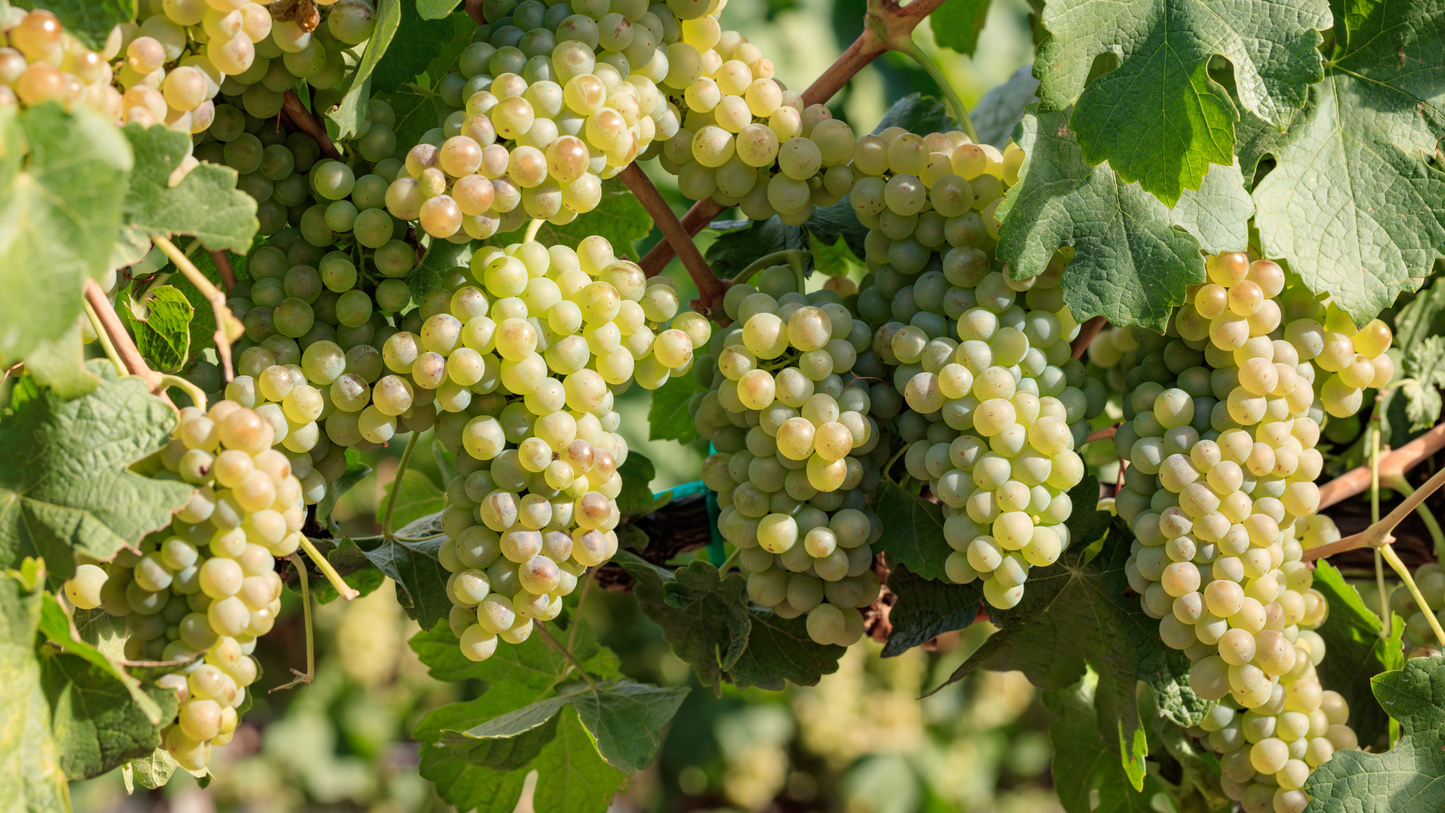
Chenin Blanc is a white wine grape variety that traces its origins to the Loire Valley in France. Known for making crisp wines with varying degrees of sweetness, it is a grape even Jancis Robinson, in her co-authored book “Wine Grapes”, says is deserving of “more recognition”.
While historical records show first accounts of it being spotted in France and is considered to have “originated” from there, it’s influence in France is declining. The total area of planting in 2008 indicated a decrease, and was standing at a mere 1.2% of the total French vineyard plantings.
It is in fact South Africa that now takes the lead globally for Chenin Blanc plantings!
Characteristics of Chenin Blanc
Chenin Blanc is well-regarded for its remarkable versatility and adaptability. One of its distinguishing characteristics is its high acidity, which allows it to produce a diverse array of wine styles, ranging from bone-dry to lusciously sweet. This acidity also grants Chenin Blanc wines excellent aging potential, often developing complex tertiary aromas over time.
The flavour profile of Chenin Blanc typically includes notes of apple, pear, and quince, complemented by hints of floral and honeyed undertones.
In cooler climates, the wines tend to exhibit more green fruit and mineral qualities, while in warmer regions, the wines often present riper and tropical fruit flavours.
This adaptability and the broad spectrum of styles make Chenin Blanc a cherished choice for both winemakers and wine enthusiasts.
Chenin Blanc Bush Vines in South Africa
The bush vines of Chenin Blanc in South Africa add a unique dimension to the wine's character and are a point of distinction in the global wine market.
Unlike trellised vines, bush vines grow in a more natural, free-standing manner, creating a sprawling, low canopy. This growth pattern allows for optimal sun exposure and airflow around the grape clusters, which is crucial in the warm South African climate. The deep-rooted bush vines access water and nutrients from deeper soil layers, enhancing the complexity and concentration of flavors in the grapes.
The resulting wines often possess intense fruit purity, with pronounced notes of peach, apricot, and tropical fruits, balanced by a refreshing acidity.
Furthermore, the older age of many South African bush vines lends a depth of character and a distinct sense of terroir, making these Chenin Blanc wines truly exceptional and sought after by connoisseurs worldwide.
Comparing Chenin Blanc from Cooler Regions of South Africa and France
Chenin Blanc from the cooler regions of South Africa and France showcases both similarities and distinct differences that reflect their respective terroirs. In both regions, cooler climates contribute to higher acidity in the wines, making them refreshing and lively on the palate. This shared characteristic makes Chenin Blanc an excellent option for sparkling wines and crisp, dry styles.
However, the flavour profiles can differ significantly between these regions. In the cooler parts of South Africa, Chenin Blanc often exhibits vibrant fruit notes such as green apple, citrus, and underripe stone fruits, with a pronounced mineral quality. These wines maintain a refreshing acidity and show a purity of fruit that is both invigorating and complex.
In contrast, Chenin Blanc from the cooler regions of France, notably the Loire Valley, tends to display a different spectrum of flavours. French Chenin Blanc often has more pronounced floral and honeyed notes, along with hints of quince and pear. The mineral aspect is also prominent, but it may express itself differently, often described as having a chalky or flinty quality.
Moreover, while both regions can produce excellent wines with aging potential, the expression of tertiary aromas in aged wines also varies. South African Chenin Blanc may develop richer tropical fruit and spice notes, while French Chenin Blanc from regions like Vouvray often matures into complex layers of nuts, baked apples, and dried apricots, interwoven with honey and vanilla.
While Chenin Blanc from the cooler regions of South Africa and France shares a foundation of high acidity and mineral qualities, their flavour profiles and aging characteristics diverge to offer unique expressions influenced by their distinct environments.
Traditional vs. Innovative: A Comparative Look at Winemaking Techniques in France and South Africa
The openness to innovative winemaking techniques has also allowed winemakers in South Africa to create a wider variety of styles with Chenin Blanc compared to their French counterparts.
South African vintners have embraced experimentation with different fermentation techniques, such as using wild yeasts, which can impart unique and complex flavors to the wine.
Additionally, the use of various aging vessels, including stainless steel, oak barrels, and concrete eggs, has enabled winemakers to refine and diversify the texture and taste profiles of their Chenin Blanc wines. This experimental approach contrasts with the more traditional methods often adhered to in France's Loire Valley, where there is a stronger emphasis on maintaining classic styles and regional identity.
Consequently, South Africa's innovative spirit in winemaking has led to Chenin Blanc offerings that range from bone-dry and crisp to rich and opulent, and even to sweet and botrytized versions, thereby expanding the scope and appeal of this versatile grape.
The Role of Chenin Blanc in South African White Blends
Chenin Blanc is a versatile grape variety that plays a crucial role in South African white blends. Its high acidity and vibrant fruit profile make it an excellent backbone for blends, providing structure and freshness. In these blends, Chenin Blanc is often paired with other varietals such as Sauvignon Blanc, Chardonnay, and Viognier. This combination allows winemakers to craft complex and balanced wines that showcase a mix of aromatics, fruit flavours, and textures.
The Chenin component typically provides bright citrus and green apple notes, while other varietals contribute additional layers of tropical fruit, floral elements, and a touch of oak influence when barrel-fermented. The result is a harmonious blend where Chenin Blanc's natural acidity and minerality ensure the wines remain lively and age-worthy. These white blends are celebrated for their versatility and are enjoyed both as refreshing, youthful wines and as more nuanced, mature expressions.
Food Pairings with Chenin Blanc
Chenin Blanc's versatility extends beyond the winery and onto the dinner table, where it pairs wonderfully with a variety of foods.
For a dry Chenin Blanc, consider dishes such as goat cheese, seafood like oysters or grilled shrimp, and light salads with vinaigrette dressings. The crisp acidity of the wine complements the tangy flavors and delicate textures of these dishes.
For richer, off-dry or slightly sweet versions of Chenin Blanc, pairings with spicy Asian cuisine, poultry with creamy sauces, or pork dishes can bring out the wine's fruitiness and balance the spice or richness of the food.
Additionally, a sweet, botrytized Chenin Blanc is an excellent match for blue cheeses, fruit-based desserts like tarte tatin, and rich pâtés. These pairings highlight Chenin Blanc's ability to enhance a wide array of flavors and textures, making it a versatile choice for any dining experience.
Explore our Chenin Blanc Collection here.
Looking for something extra special? Try “The 1947”, it’s made from a bush vine that’s over 70 years old, from a 4th generation Producer whose founder, the Great Grandfather of the current generation, planted in 1947. The flavour and the history will surely impress!
Enjoy $19.47 off when you purchase 2 bottles this month, while stocks last.
